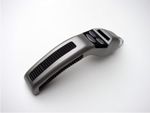Personal phaser
| Starfleet Equipment & Devices |
|---|
| • COMMUNICATOR | • TRICORDER | • PADD |
| • MEDKIT | • PERSONAL PHASERS | • PHASER RIFLES & HEAVY WEAPONRY |
|
The personal phaser is the primary sidearm of Starfleet personnel.
TypesTwo types of personal phasers are currently in use:
More powerful phaser rifles and other weapons are also available for special circumstances and missions when heavy hostile retaliation is expected. Current ModelsType 1 PhaserBecause of their small size, type 1 phasers are informally known as "cricket" phasers by Starfleet personnel. The current type 1 phaser model was introduced in 2373. Type 2 PhaserThe current Type 2 phaser model was introduced in 2379. This model in particular is informally referred to by personnel as a "dolphin" phaser because of its redesigned emitter compared to earlier models. Type 2 Mark VII "Aquila" PatternAn updated model of the standard Type -2 that was used throughout the early 24th Century, the Aquila pattern was designed for use by the Federation Marine Corps, Starfleet Hazard teams, and for more robust away missions. Built on the more sturdy ancient Terran design for firearms, the Aquila was designed to be more durable and further in line with the primary weapons often used by the marines. Along with these design improvements the Starfleet Corps of Engineers simplified the power scale and restructured the emitter to fire phaser pellets instead of a concentrated phaser beam. This change removed the Aquila from a ‘tool’ category and grounded it firmly as a weapon. Instead of a scaling power level from one to sixteen, which was used primarily to credit the original models as a cutting tool, the Aquila has five settings. Light Stun, Heavy Stun, Disruption, Lethal (Kill), and Disintegrate. The final setting has a limited range and spends the weapons power supply quickly. A blue digital readout on the right and left side of the weapon displays the remaining charge and current setting. Specifications
OperationsThe phaser energy is released through the application of the Rapid Nadion Effect (RNE). Rapid nadions are short-lived subatomic particles possessing special properties related to high-speed interactions within atomic nuclei. Among these properties is the ability to liberate and transfer strong nuclear forces within a particular class of super-conducting crystals known as fushigi-no-umi. The crystals were so named when it appeared to researchers at Starfleet's Tokyo R&D facility that the materials being developed represented a virtual "sea of wonder" before them.
|





